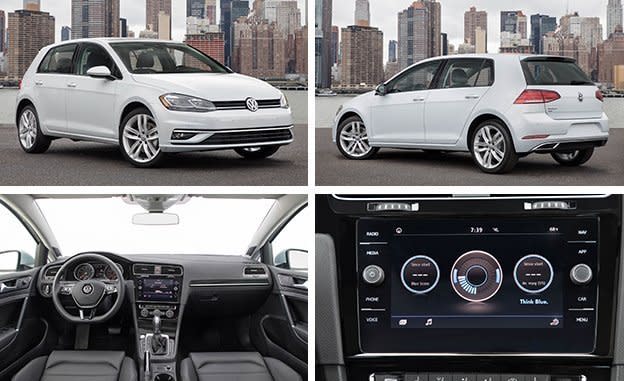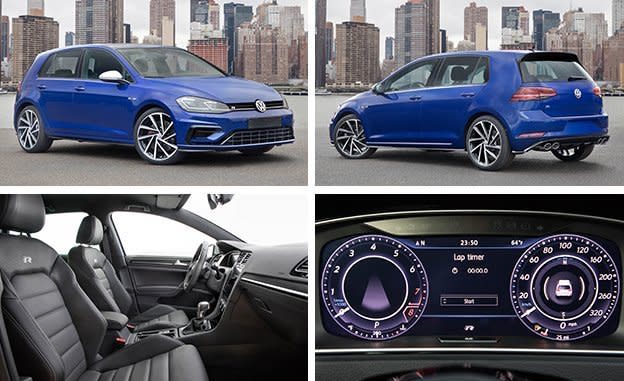2018 Volkswagen Golf, GTI, and Golf R: Updates for Longtime Favorites

Volkswagen is taking a cautious approach with the mid-cycle update to the Golf hatchback and its performance derivatives, the sprightly GTI and the even quicker Golf R. Subtle though the changes may be, however, they are nonetheless comprehensive and worth reporting, especially since we’re talking about a car that has been on our 10Best Cars list for the past 10 years. This isn’t just a car that’s important to VW; it’s important to us.
The Golf
Changes to the exterior are minor enough that you’ll hardly notice them unless the new model is parked right next to the old one. All Golfs and GTIs get LED daytime running lights, with full-LED headlamps available as an upgrade, replacing the previous bixenons. The front and rear bumpers have been restyled—now with even straighter lines!—and new LED taillamps dress up the derrières of all Golf models from the lowly Golf S to the mighty Golf R. New wheel designs and paint choices also arrive for 2018.

New interior trim and materials dress up the 2018 Golf’s cabin a bit, and most versions enjoy more standard equipment. The S, for example, gets a 6.5-inch touchscreen infotainment system to replace last year’s 5.0-incher, as well as rain-sensing wipers. Golf SE models upgrade to a new 8.0-inch touchscreen display, and the available forward-collision warning and automated emergency braking systems now add pedestrian recognition. Top-dog Golf SEL models add adaptive cruise control and an auto-dimming mirror. No changes were made to the 170-hp turbocharged 1.8-liter four-cylinder serving all non-GTI Golf models or to their transmissions—yes, the manual still offers only five forward speeds, while the automatic has six.

The GTI
It’s a different story for one of our favorite cars, the GTI. The turbo 2.0-liter four-cylinder in the base GTI S gets a 10-hp boost for a total of 220 horsepower at 4700 rpm, with torque unchanged at 258 lb-ft at 1500 rpm. This brings it in line with the 2018 GTI SE and Autobahn models (the GTI Sport trim level has been dropped). Opt for a GTI S model with the six-speed dual-clutch automatic transmission, and you’ll get engine auto stop/start functionality, too.
If you spring for the GTI SE, you’ll now get the beefier brakes from the Golf R, an electronically actuated torque-sensing limited-slip differential, and full LED lighting. The infotainment screen grows to 8.0 inches, and seating surfaces are the traditional Clark plaid cloth, with leatherette optional. The GTI Autobahn comes standard with adaptive dampers plus the aforementioned 8.0-inch touchscreen in the dash, which includes navigation.

The Golf R
While the turbo 2.0-liter inline-four in the range-topping, and all-wheel-drive, Golf R still makes 292 horsepower and 280 lb-ft of torque, the optional automatic transmission gets an extra cog and is now a seven-speed dual-clutch unit. Newly standard for the base Golf R are LED exterior lighting, an 8.0-inch infotainment screen, and auto stop/start on automatic models. The nifty Volkswagen Digital Cockpit instrument cluster—similar to the Virtual Cockpit found in the latest Audis—is a new standard feature. Golf Rs equipped with adaptive dampers and navigation also come with pedestrian monitoring for the collision-warning and automated emergency braking systems.
While these mid-cycle changes aren’t as thorough as those made to the Golf in other markets—European Golfs can be ordered with a 9.2-inch infotainment screen with gesture control, two fuel-sipping 1.5-liter four-bangers, and adaptive cruise control—they should be enough to keep it competitive, provided prices don’t rise much from current levels. We won’t know how much VW is going to ask for the 2018 Golf, GTI, and Golf R until closer to their fall on-sale dates. Since they’re being pitched as value-added propositions, we don’t expect prices to rise more than a few C-notes above their current levels. Figure, then, $21K will buy you a base Golf S, $26K a GTI S, and around $37K a basic Golf R.

 Yahoo Autos
Yahoo Autos 